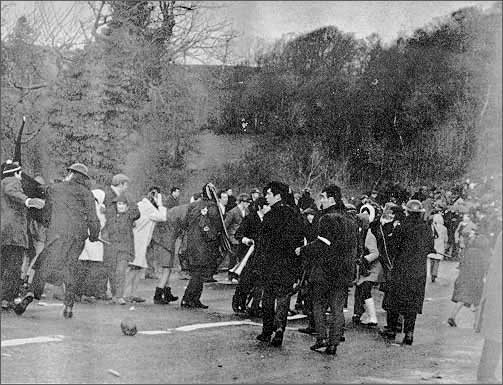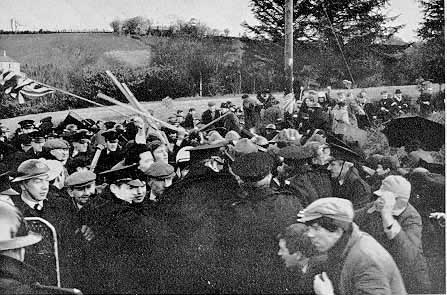 CAIN Web Service
CAIN Web Service
The People's Democracy March - Chronology of Main Events
[CAIN_Home]
[KEY_EVENTS]
[Key_Issues]
[Conflict_Background]
PD MARCH:
[Menu]
[Reading]
[Summary]
[Background]
[Chronology]
['Burntollet']
[Sources]
Page Compiled: Martin Melaugh
Material is added to this site on a regular basis - information on this page may change
Chronology of main events surrounding the People's Democracy March from Belfast to Derry
Saturday 5 October 1968
Start date of the current 'Troubles'
A civil rights march in Derry, which had been organised by members of the Derry Housing Action Committee (DHAC) and supported by the Northern Ireland Civil Rights Association (NICRA), was stopped by the Royal Ulster Constabulary (RUC) before it had properly begun. The marchers had proposed to walk from Duke Street in
the Waterside area of Derry to the Diamond in the centre of the
City. Present at the march were three British Labour Party Members
of Parliament (MP), Gerry Fitt, then Republican Labour MP, several
Stormont MPs, and members of the media including a television
crew from RTE. Estimates of the number of people taking part
in the march differ. Eamonn McCann (one of the organisers of
the march) estimated that about 400 people lined up on the street
with a further 200 watching from the pavements. The RUC broke-up
the march by baton-charging the crowd and leaving many people
injured including a number of MPs. The incidents were filmed
and there was world-wide television coverage. The incidents in
Derry had a profound effect on many people around the world but
particularly on the Catholic population of Northern Ireland.
Immediately after the march there were two days of serious rioting
in Derry between the Catholic residents of the city and the RUC.
Wednesday 9 October 1968
2,000 students from the Queen's
University of Belfast (QUB) tried to march to Belfast City Hall
to protest against 'police brutality' on the 5 October 1968 in
Derry. The marched was blocked by a counter demonstration led
by Ian Paisley. A three-hour sit-down demonstration followed
the blocking of the march. [Following the events of the day the
People's Democracy (PD) organisation was formed. PD became an
important force in the civil rights movement and a number of those
who were leading members in the organisation, for example Bernadette
Devlin and Michael Farrell, became prominent political activists.]
The Derry Citizen's Action Committee (DCAC) was formed from five
protest organisations which had been active in the city. Ivan
Cooper was the first chairman and John Hume the first vice-chairman
of the DCAC.
Wednesday 16 October 1968
The People's Democracy (PD)
organised a march of 1,300 students from the Queen's University
of Belfast to the City Hall in the centre of the city.
Thursday 24 October 1968
The People's Democracy (PD)
organised a protest demonstration at Stormont Parliament buildings,
Belfast. (?)
Sunday 17 November 1968
A policy of civil disobedience
was adopted by the Nationalist Party at its annual conference.
Friday 22 November 1968
Terence O'Neill, then Northern
Ireland Prime Minister, announced a package of reform measures
which had resulted from meetings in London with Harold Wilson,
then British Prime Minister, and James Callaghan, then British
Home Secretary. The five point reform plan included:
- a nine member 'Development Commission'
to take over the powers of the Londonderry Corporation;
- an ombudsman to investigate complaints
against government departments;
- the allocation of houses by local
authorities to be based on need;
- the Special Powers Act to be abolished
as it was safe to do so; and
- some reform of the local government
franchise (the end of the company votes).
Friday 20 December 1968
The People's Democracy (PD)
announced that its members would undertake a protest march from
Belfast to Derry beginning on 1 January 1969.
1969
January 1969
Wednesday 1 January 1969
Approximately 40 members
of People's Democracy (PD) began a four-day march from Belfast
across Northern Ireland to Derry. The Northern Ireland Civil
Rights Association (NICRA) and some nationalists in Derry had
advised against the march. The march was modelled on Martin Luther
King's Selma to Montgomery march. The first day involved a walk
from Belfast to Antrim. [Over the next four days the number of
people on the march grew to a few hundred. The march was confronted
and attacked by Loyalist crowds on a number of occasions the most
serious attack occurring on 4 January 1969.]
Thursday 2 January 1969
The People's Democracy (PD) march continued,
on day two, from Antrim to Maghera.
Friday 3 January 1969
The third day of the People's Democracy
(PD) march took it from Maghera to Claudy.
Saturday 4 January 1969
 The fourth, and final, day
of the People's Democracy (PD) march took the marchers from Claudy
to Derry. Seven miles from its destination, the People's Democracy
(PD) march was ambushed and attacked by a loyalist mob at Burntollet
Bridge. The ambush had been planned in advance and around 200
loyalists, including off-duty members of the 'B-Specials', used
sticks, iron bars, bottles and stones to attack the marchers,
13 of whom received hospital treatment.
The fourth, and final, day
of the People's Democracy (PD) march took the marchers from Claudy
to Derry. Seven miles from its destination, the People's Democracy
(PD) march was ambushed and attacked by a loyalist mob at Burntollet
Bridge. The ambush had been planned in advance and around 200
loyalists, including off-duty members of the 'B-Specials', used
sticks, iron bars, bottles and stones to attack the marchers,
13 of whom received hospital treatment.
 The marchers believed
that the 80 Royal Ulster Constabulary (RUC) officers, who accompanied
the march, did little to protect them from the Loyalist crowd.
As the march entered Derry it was again attacked at Irish Street,
a mainly Protestant area of the city. Finally the Royal Ulster
Constabulary (RUC) broke up the rally that was held in the centre
of the city as the march arrived. This action, and the subsequent
entry of the RUC into the Bogside area of the city, led to serious
rioting.
The marchers believed
that the 80 Royal Ulster Constabulary (RUC) officers, who accompanied
the march, did little to protect them from the Loyalist crowd.
As the march entered Derry it was again attacked at Irish Street,
a mainly Protestant area of the city. Finally the Royal Ulster
Constabulary (RUC) broke up the rally that was held in the centre
of the city as the march arrived. This action, and the subsequent
entry of the RUC into the Bogside area of the city, led to serious
rioting.
Sunday 5 January 1969
Terence O'Neill, then Prime Minister of Northern Ireland, issued a statement on the events since 1 January 1969.
Saturday 11 January 1969
There was rioting in a number
of areas of Northern Ireland particularly in Derry and Newry.
Wednesday 15 January 1969
Terence O'Neill, then Northern
Ireland Prime Minister, announced the setting up of an official
inquiry into the disturbances in Derry and elsewhere. The inquiry,
under the chairmanship of Lord Cameron, a Scottish judge, was
to look into the causes of the civil unrest.
| 

